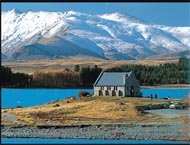Lake Tekapo - a stargazers' heaven in New Zealand
 Wellington - The stars shine in the crystal-clear night sky over Lake Tekapo, at the foot of New Zealand's Southern Alps, more brilliantly than just about anywhere else on earth and the area is already renowned as a stargazers' heaven for tourists.
Wellington - The stars shine in the crystal-clear night sky over Lake Tekapo, at the foot of New Zealand's Southern Alps, more brilliantly than just about anywhere else on earth and the area is already renowned as a stargazers' heaven for tourists.
Now, New Zealand is bidding to have the area declared a "Starlight Reserve" and a world heritage site recognised by the United Nations Educational, Scientific and Cultural Organisation (UNESCO).
With astronomers claiming that one-fifth to half of the world's population are unable to view the stars because urban light pollution dims their view of the night sky, so-called astro-tourism is seen as a growth travel area.
Tourism New Zealand reports that three-quarters of Japanese visitors list stargazing as the main reason they wanted to visit the country and no place provides a better opportunity than Tekapo, a tiny village on the edge of the 83-square kilometre lake.
An observatory, which overlooks the village atop 1,031-metre Mount John, has six telescopes, including the country's biggest, measuring 1.8 metres across, which is able to observe 50 million stars each clear night.
Aware that the Mackenzie region, named after a notorious 19th century Scottish sheep drover, is in a priceless tourist and scientific position, the local district council has imposed strict lighting regulations.
It has only sodium street lamps shielded from above and decrees that all household lights must beam down. Floodlights are forbidden and all outdoor lighting must be switched off between 11 pm and sunrise to maximise the view of the heavens.
"We want to protect one of the Mackenzie's most valuable assets, its dark, starry, sky," says
Graeme Murray, a director of Earth and Sky which operates at the Mount John Observatory, in association with Canterbury and Nagoya Universities, and of the Mackenzie Tourism and Development Trust.
About 1.4 million tourists a year have visited Tekapo already and he estimates this number could double, if the region is given UNESCO world night sky heritage status.
Margaret Austin, a former New Zealand cabinet minister, is a member of a UNESCO committee that met in Paris this month to discuss the proposal.
She said that a working party is examining it before a world heritage meeting in Seville, Spain, in July and if approved it would go to the UNESCO general conference in October for adoption.
It would be another year before it became official, but the wait would be worth it, Austin said. "Whenever world heritage sites are suggested it results in enormous interest worldwide. It gives recognition, status and publicity."
Murray said, "It has never been done anywhere in the world, so we hope we'll be successful."
He said that astronomers from Nagoya University in conjunction with New Zealand universities were involved in a Mount John project that is at the leading edge of searching for another planet similar to Earth.
It is envisaged that a Starlight Reserve would also embrace the national park in the Southern Alps that includes New Zealands highest peak, the 3754-metre high Mount Cook. (dpa)